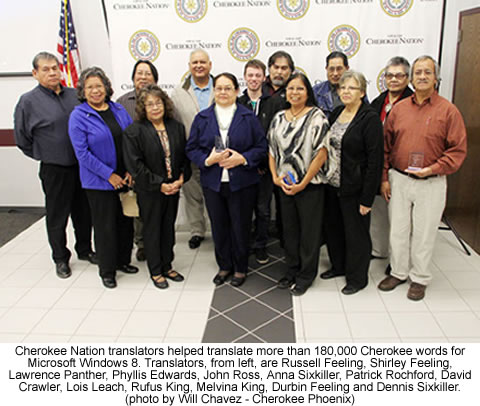 |
Canku Ota
|
 |
|
(Many Paths)
|
||
|
An Online Newsletter
Celebrating Native America
|
||
|
January
2013 - Volume 11 Number 1
|
||
|
|
||
|
Microsoft Integrates
Cherokee in New Operating System
|
||
|
by Will Chavez Cherokee
Phoenix
|
||
 TAHLEQUAH,
Okla. – Microsoft and Cherokee Nation officials celebrated the
integration of the Cherokee language into the new Windows 8 operating
system on Dec. 19 at Sequoyah High School. TAHLEQUAH,
Okla. – Microsoft and Cherokee Nation officials celebrated the
integration of the Cherokee language into the new Windows 8 operating
system on Dec. 19 at Sequoyah High School.
Cherokee is the first Native American language to be integrated into a Windows system. Sixteen CN language translators and other staff members worked with Microsoft to prepare for the integration of Cherokee into Windows 8. "On behalf of Microsoft, it's our honor and pleasure to be here to announce the language interface pack officially available for the Cherokee language on the Windows 8 platform operating system," Carla Hurd, Microsoft Local Language Program manager, said. "My hat goes off to all of the translators, all of the staff, all of the support that went into this huge effort. I think of this as just the beginning. We've already started on Office 2013, which is the next step. It's an even bigger project. Microsoft products are everywhere, and your language will in turn be everywhere." More than 20 years ago, Microsoft employee Tracy Monteith, an Eastern Band of Cherokee Indians citizen, asked the company to include his native language in the computer's core operating system. It wasn't until 2010 that CN language technologists met with Monteith and others at Microsoft to get the project going. A team of translators was assembled, ranging from tribal employees, community speakers and Cherokee college students. "It became a rewarding experience for me to know that in the future the language is going to be there. I'm just proud to be a part of this effort and being a translator for Microsoft. And I thank the Microsoft people for allowing us to do this," CN translator Russell Feeling said. Lois Leach, a 56-year-old clerk in the Nation's Roads Department,
logged more than 100 volunteer hours during the past year translating
computer terms that did not exist when the Cherokee language originated.
Principal Chief Bill John Baker said Cherokee translators translated more than 180,000 words for the program and that this was the largest Cherokee translation project since the Bible was translated in the 1800s. "You have done great work, and you are truly heroes of the Cherokee
Nation," Baker said to the translators. "For a people to lose their language is probably the most terrible thing that can befall a people," he said. "We thank Microsoft for putting their great resources to use. They'll never make any money off this project, we know that, but they're going to help keep the Cherokee spirit, the Cherokee language alive forever." In November, the tribe partnered with Google to add Cherokee to it email service Gmail. Cherokee speakers can now exchange emails using Gmail and instant message chats entirely in the Cherokee syllabary. In March 2011, Google added Cherokee as an interface language, meaning anyone who reads and writes Cherokee can look up virtually anything on the World Wide Web using the Cherokee language. In another effort to perpetuate the language, this past fall Cherokee translators dusted off the numeric system developed by Sequoyah, the inventor of the Cherokee syllabary. Translation Specialist John Ross from the CN Translation Department studied and figured out the numeric system in an effort to create a font to make it useful for printing and computers. Sequoyah created unique, single symbols for numbers 1 through 19 and numbers 20, 30, 40, 50, 60, 70, 80, 90 and 100. So to create the number 31, the symbol for 30 and 1 would be used together or to create the number 500 the symbol for 5 and 100 would be used together. Ross created a symbol for 0 and created symbols for 1 billion and 1 trillion. In 2010, the Unicode system was introduced for the Cherokee language. The numbering system associates numbers to language characters and creates a uniform system for writing and reading Cherokee on computers. "Unicode is the international standard for all computer technology now – cell phones, computers, video games…anything that's digital uses Unicode to display languages," Language Technologist Roy Boney said. A European group called the Unicode Consortium determines computer standards and a numbering system for languages. Language fonts receive their own numbering systems using the consortium's standards. "Cherokee has been assigned a (number) code group by the Unicode Consortium. So it is standard across the world," Boney said. In 2010, the Cherokee syllabary became available on iPhones and the iPod Touch after three years of developing software with Apple Inc. In 2009, Facebook added Cherokee to its popular social web site. Boney is one of 14 translators on Facebook who helps Cherokee people maintain cultural ties by allowing speakers registered on the site to translate a glossary of common Facebook words and phrases. |
|
|
||
|
|
||
| Canku Ota is a free Newsletter celebrating Native America, its traditions and accomplishments . We do not provide subscriber or visitor names to anyone. Some articles presented in Canku Ota may contain copyright material. We have received appropriate permissions for republishing any articles. Material appearing here is distributed without profit or monetary gain to those who have expressed an interest. This is in accordance with Title 17 U.S.C. Section 107. | ||
|
Canku Ota is a copyright ©
2000 - 2013 of Vicki Williams Barry and Paul Barry.
|
||
 |
 |
|
|
The "Canku
Ota - A Newsletter Celebrating Native America" web site and
its design is the
|
||
|
Copyright ©
1999 - 2013 of Paul C. Barry.
|
||
|
All Rights Reserved.
|
||